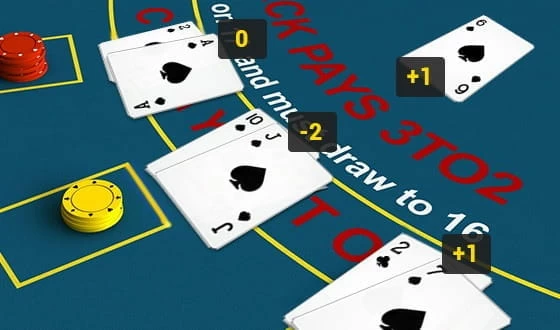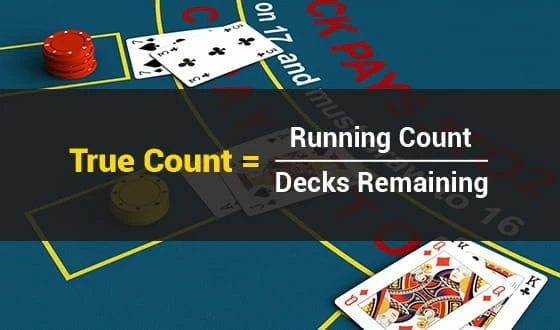Blackjack Card Counting: A Complete Guide
For decades, casino players have tried and tested various methods in order to take on the house. Blackjack is one of the most popular games in the world and has a rich history of both successful and unsuccessful strategies. Blackjack card counting is by far the most famous of these strategies. Counting cards dates back to the early 1960s and since then many innovative players have developed their own variants on the system. This guide will provide an in-depth view of how counting cards in blackjack is achieved, the variations and simplifications, as well as the history of the method. Finally, it will discuss whether or not card counting systems are illegal and try to debunk some of the longstanding card counting myths.
Counting Cards in Blackjack: Step by Step
Most people think that counting cards in blackjack is all about memorising each card, but that is not the case. In reality, it’s a lot simpler than that. The idea behind card counting is to decrease the inherent casino house edge by keeping a running tally of all high and low valued cards that are dealt in a game. With this information, players can choose to bet more with less risk when the count gives a favourable advantage as well as reduce losses during an undesirable count.
Card counting in blackjack is based on the notion that high cards (especially aces and 10s) help the player more than the dealer, while low cards benefit the dealer. Basic card counting assigns a positive, negative, or zero value to each card that is dealt.
When you understand the value of each card, you can begin the running count which is the process of adding and subtracting the values of each card as they are dealt. Once you know the running count, the next thing you need to calculate is the true count. This is achieved by dividing your running count by the number of decks remaining in the game. The higher the true count, the higher your advantage. Now that you know the basics, follow the below example and see how you get on.
It can seem a little daunting at first but with a little practice, anyone can learn blackjack card counting. The conservative estimate for learning how to keep a running count of a single deck is approximately 10 hours. The step that is most difficult to learn is converting to the true count which can take around 50 hours. Some players actually invite people to specifically play card counting blackjack in order to give each other the chance to practice openly.
Variations and Simplifications
Since the first blackjack card counting system was created in the early 1960s, many other systems have been developed. Each with their own varying levels of difficulty and accuracy for measuring the low to high card ratio. Some systems are relatively simple but yield less effective results. Others can be quite complicated to learn but offer better results. Below, we have provided a summary of all the different blackjack card counting systems so that you can get an idea of which method you want to try first.
Hi-Lo System
This is, without doubt, the most well-known and widely used card counting strategy. Created in 1963 by Harvey Dubner, the Hi-Lo Strategy is one of the more straight-forward variants for newcomers to learn. Basic card counting assigns a positive, negative, or zero value to each card that is dealt. In the Hi-Lo system, low cards (2 – 6) are valued at +1 whilst high cards (10 – Ace) are valued at –1. The middle cards (7 – 9) are considered as neutral cards. Next, you begin the running count. For example, if the first five cards are a Jack, 7, 3, King and an Ace, the running count would be –2. Following this we calculate the true count. If your running count is –2 and the dealer has 5 decks left, this means your true count is -2/5 = -0.4. If the true count is 0 or below, the house has the edge.
| Difficulty | Accuracy | House Edge |
|---|---|---|
| 3/5 | 4/5 | 2/5 |
A true count of 1 technically means you and the casino are on even terms. The higher the true count is above 1, the better the edge you have and the more you should bet. The Hi-Lo system is considered as one of the most accurate as it is a balanced system. This is because when you add up all of the cards, you will end with a count of 0.
Speed Count System
The Speed Count system was developed by Dan Pronovost as a simpler alternative to the Hi-Lo system. Traditional blackjack card counting systems track the ratio of low and high-value cards during a game which can require a lot of practice and concentration. Speed Counting utilises the fact that the average number of cards in a hand is 2.7 meaning that more people are likely to take three cards than 2. Since there are just 5 low cards for every 13 high cards in a 52-card deck we can work out an average of 1.03 low cards for every hand of blackjack played. With this information, we simply count the number of low cards on the table as +1 and at the end of each round, subtract the total number of hands dealt.
| Difficulty | Accuracy | House Edge |
|---|---|---|
| 1/5 | 2/5 | 4/5 |
The higher your count is, you know that there are fewer low cards in the game giving you the advantage. The creator has admitted that other more complex systems could yield more accurate results but cites that his method is far easier to learn and thus more useful to the average blackjack card counting player.
K-O System
The K-O, otherwise known as the Knockout system was created in 1998 by Ken Fuchs and Olaf Vancura. The strategy is identical to the Hi-Lo system except that the 7 card is given a value of +1 meaning that the final count after one deck is +4. This is because there are now 24 low cards and 20 high cards meaning we are working with an unbalanced system. One of the benefits of the K-O system is that the player no longer has to calculate the true count. As before with the Speed Count, you only have to calculate the running count with the updated K-O values. If the running count is positive, you should increase the size of your bets and when it is negative reduce your bet. The higher the count, the more you should bet.
| Difficulty | Accuracy | House Edge |
|---|---|---|
| 2/5 | 3/5 | 3/5 |
One thing you need to take note of is the amount of decks in the game when you start as this will determine your starting count. In a single deck game, your starting count is always 0. If there are 2 decks, start at –4; 6 decks at –20, 8 decks at –28 and so on. It’s important to note, that this system does sacrifice accuracy for convenience. For card counting beginners, it’s a really good starting point but it is not the most accurate one available.
Omega II System
More experienced blackjack players may have heard of the almighty Omega system created by Bryce Carlson. The system rose to prominence in the 1990s as an elite technique for taking on the house. Whilst the name itself may give connotations of grandeur and difficulty, the mathematics behind the Omega system are not that dissimilar to both the Hi-Lo and the K-O methods. Whilst the former methods only utilise –1, 0 and +1 in the card counting, the Omega system uses a wider range of values. For instance, the cards 2, 3 and 7 are +1, 4 through 6 are +2, 8s and Aces are now 0, 9 is –1 and 10 through to the King have a value of –2.
| Difficulty | Accuracy | House Edge |
|---|---|---|
| 5/5 | 5/5 | 1/5 |
Now you see where the difficulty comes in. The method is essentially the same as the Hi-Lo system, however, memorising the card values is a lot harder as they are not in order. The player who takes the time to learn it will have an extreme advantage of the house as the system is known to be the most accurate of all the card counting methods.
Counting Cards in Blackjack: Why It Works
Now that you have a better understanding of the all the different systems, we will look into why card counting is so effective. In a regular game of blackjack played with a single deck of cards, the probability that the casino will win is essentially nil. This makes blackjack different from almost every other game as the house edge is not fixed. The odds of being dealt a natural blackjack is entirely dependent upon the cards that are in play and the remaining cards in the deck. Therefore, the probability of winning any hand can be dramatically improved by knowing the inherent value of the cards still in the deck. For instance, if the mix of cards remaining in the deck contains high-value cards, the odds of winning are in the player’s favour. The discovery of this relationship between a card’s inherent value and understanding how many of the high/low-value cards remain in the deck gifted the player with the knowledge to bring down the house and was ultimately the birth of all card counting systems.
Card Counting in Blackjack Online
It is possible to count cards online however it is not worth the time and effort if you are looking for economic results and rewards. Due to all online casino games using a Random Number Generator, the software automatically shuffles the deck after every hand essentially making it impossible to count cards for profit successfully. Even in live dealer games, the cards are shuffled after every hand. However, trying to count cards online is not completely without its uses. As a tool for practicing how to memorise the value of cards and calculate the running count, online blackjack card counting is really useful. After all, dealing to yourself at home can become very boring and tiresome very quickly after all. If you are interested in online blackjack, check out our introduction to the best online blackjack casinos in the UK.
The History of Blackjack Card Counting Systems
The first person credited with having the idea of discovering an edge in blackjack counting cards was a man by the name of Jeff Marcum. In 1948, he created his very own card counting method that enabled him to become one of the game’s first professional players. Over a decade later in 1961, former casino owner Harold Smith published a book called, “I Want to Quit Winners”, which advised players to bet bigger when there are more aces left in the deck. However, these two pioneers of card counting where later eclipsed by Edward Thorp who, in his book, “Beat the Dealer”, published a year later in 1961, proved mathematically that counting cards in blackjack could overcome the house advantage.
Edward Thorp – The Godfather of Card Counting
Beat the Dealer, by Edward Thorp was the first book that contained mathematically correct card-counting systems that could be used to take down casinos. The book, written in a self-help style, enabled players from all over the world to learn how to count cards using Thorp’s ‘Top 10 Count’ method. It was an enormous success and became a NY Times Bestseller just one year after publishing. Utilising the IBM 704 as a research tool, Thorp dissected the game of blackjack and created his model on the probabilities of winning. His legacy goes far beyond the game of blackjack. He was also a mathematics professor at multiple prestigious Ivy League universities, a hedge fund manager and one of the pioneers of the modern application of probability theory.
The MIT Card Counting Team
For over two decades, a group of students and ex-students from MIT terrorised casinos all over the world. They became known as the MIT Blackjack team. It began back in 1979 when a professional player called Bill Kaplan approached a group of students who had signed up for a card counting class. He convinced them to travel with him to Atlantic City to take advantage of a recent ruling that said that card counting was no longer banned in casinos. Students J.P. Massar and John Chang were considered the core members of the initial team and went on to be team managers throughout the group’s history.
The team consisted of managers who would oversee the whole operation, the signaller whose job was to locate hot tables and then the ‘big player’ who would join a game when the signaller identified a count that was favourable and start betting big. During the team’s most successful run, Jeff Ma and Mike Aponte were the big players and are credited for most of the team’s success. The group’s successful run came to an end in 2000 when they chose to disband, citing casinos becoming smarter at identifying and catching card counters as the primary reason.
Are Blackjack Card Counting Systems Illegal?
It is a common misconception that counting cards in blackjack is illegal. A misconception that casinos worldwide want you to believe. It is true that players have been removed if suspected of card counting, but this is no different than a casino removing a player who is causing a public disturbance. It operates under the right that casinos like shops may refuse service to anyone they choose. Because of this, it is not beyond reason that pit bosses would want to remove a player who they suspect trying to increase their own profit-making potential through card counting. Despite this, the reality is that counting cards is simply a mental exercise within a player’s head played entirely within the rules of a blackjack game and thus, completely legal. This does not stop pit bosses from going to extreme measures to stop you from trying.
Common Casino Counter Measures
Casinos do everything in their power to discourage or outright stop card counting. Within their walls, pit bosses are monitoring everything. You may have heard of the ‘eye in the sky’ pertaining to casinos extensive use of camera surveillance. Well, it goes even further than that. Some establishments have sensors inside their playing chips allowing them to monitor and track betting patterns at different tables. Coupled with this, there are tables that can track exactly what card comes out of the shoe with card-reading technology under the felt, enabling analysts to compare this information with how card counters might be betting.
Casinos have also started using facial recognition technology to identify known card counters from a database. They even monitor people who meet the description of a ‘typical’ card counter. This is usually a 21-35-year-old Caucasian male who is slightly overweight and wearing casual clothing. The most common countermeasures known are the use of multiple decks to make it more difficult to track cards, preventing mid-shoe entry to new players and enforcing lower payouts on games.
Common Card Counting Myths Busted
Counting cards has become famous in popular culture due to the success of many blackjack movies and books. However, because of some of these dramatized versions of real-life events, many misconceptions about the practice have been born.
You Have to Be a Genius to Do It
Contrary to popular belief, you do not have to be a genius to count cards. If you were to ask 100 different people about what they think card counting is, many would say that it involves memorising every card in the deck or something along these lines. As we have discussed earlier in this guide, it is a lot simpler than that. All players have to do is remember the value of each card and make some simple additions and subtractions, and for some systems a little division too.
You Have to Have a Lot of Money to Count Cards
It’s true that the more you bet, the more money you stand to win in real terms. However, in terms of actual percentage returns, the size of your bankroll really plays no part. The fact remains that successful card counters will have a narrow mathematical edge over the casino which will help them win more bets than they lose over time. If your bankroll is low, you should stick to tables with lower bet sizes. What’s important is your ability to withstand short-term losing streaks so you can play big with the hot streaks begins.
Conclusion
Card counting in blackjack has become one of the most well-known and commonly used strategies to beat casinos. Contrary to what most people think, it is completely legal and not that difficult to learn. We hope you find this guide useful as a starting point on your journey to learning how to count cards. Have fun with it, but don’t expect to become a millionaire overnight. If you are interested in more than just blackjack, we also provide in-depth reviews of all the best online casinos in the UK.





